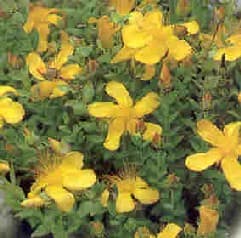How to Grow St. John's Wort Herb Plants

About Growing St. John's Wort Plants in Your Herb Garden
Growing St. John’s Wort plant is easy to grow. There are over three hundred varieties. It is used primarily for medicinal purposes. St. John’s Wort is believed to have been named after St. John the Baptist. It originated in Europe and Asia, where it grew wild in woods, fields, and along roadsides. Quickly spreading, St. John’s Wort is found all over the U.S., and the world. To many farmers, it is a weed they try to keep out of their fields.
St. John’s Wort is a perennial herb that grows into a small shrub if allowed. With attractive leaves, this herb has clusters of bright yellow flowers, that bloom from July through August.
Did you Know? St. John’s Wort was used to ward off evil spirits and witches. I think it works, as I have not seen evil spirits in my herb garden.
Flowers Bloom: Late Spring through early Fall
Flower Colors: Yellow
Plant height: 1 to 3 feet tall.
Hardiness Zones: 4 – 9
Hypericum Moseranum
Medicinal Uses
St. John’s Wort herbs are used to treat anxiety and depression. This herb has also been used for kidney ailments, incontinence, and pulmonary problems.
A tincture is made from the active ingredient “hypericin”. You can easily make it yourself, or buy it in stores. The leaves are also used in teas.
St. John's Wort Plant Propagation
St.John’s Wort plants are started from seed. Start seeds indoors, 6 to 8 weeks before the last frost in your area.
Note: For indoor starts, we recommend using a heated germination mat, to increase the speed of germination. And, it, results in a higher germination rate.
Growers also start plants from cuttings.
Final Plant Spacing: Space seedlings, or thin plants 10 to 18 to 24 inches apart.
Days to Germination: 10 – 21 days.
How to Grow St. John's Wort Herb Plants
Almost any area of your garden or flower bed is good for growing St. John’s Wort. They grow well in full to partial sun, tolerating shade. They prefer moist, and light soils. Sandy and coarse soils are fine.
Being a perennial, St. John’s Wort is hardy. To assure a good start, sow seeds outdoors after the last frost in your area. When seedlings are about two inches tall, thin or transplant them. Different varieties will require varying amounts of space.
Once started, these plants will grow well with little or no attention. Fertilizer always helps but is only necessary in the poorest of soils. Just make sure to provide water during an extended period of dry weather.
Ideal pH: 5.5 – 7.3
Harvesting and Drying St. John's Wort Leaves
You can harvest St. John’s Wort leaves as soon as there is enough to use. Pick leaves in the morning, when the oils are at their maximum.
Harvest the entire plant in the fall before the first frost. Hang plants upside down to dry, in a well-ventilated area. After they are dry, remove the leaves and flowers. More on Drying Herbs
Insect and Plant Disease Problems
Related Articles
Please support our site. Shop for:
- rmmatthews100@hotmail.com
- 585-721-6528
- Rochester, NY
©1999-2024 GardenersNet.Com, All Rights Reserved

